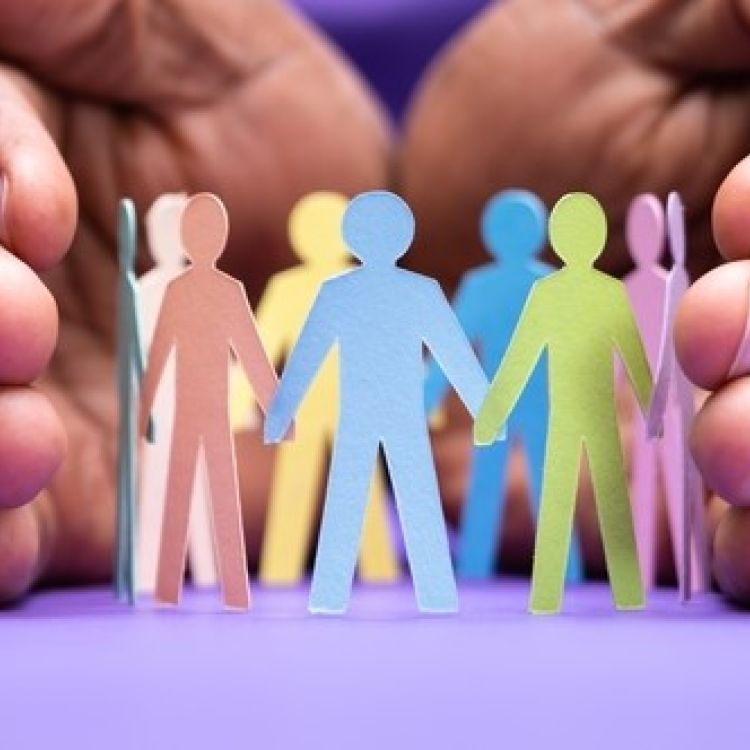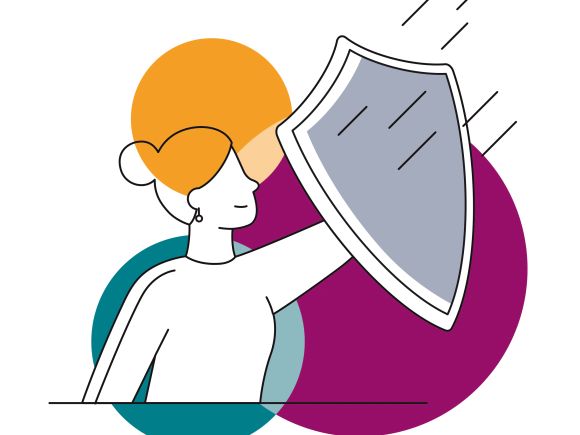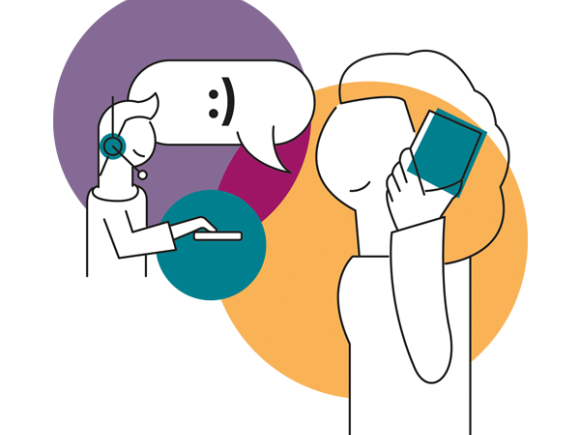Safeguarding
Safeguarding is a process of making sure children and adults who could be considered vulnerable or at risk are protected
from being abused, neglected or exploited. People and organisations work together to tackle abuse and neglect.


What is Safeguarding
Safeguarding is everyone's responsibility and we work closely with other agencies to promote people's welfare and protect them from harm.
Everyone employed by us has a role to play in identifying concerns, sharing information and taking prompt action when issues are identified.
You can find out more in our Statement of Intent and read our Safeguarding Policy here.
Housing providers have a duty to co-operate with local authorities implementing their statutory duties around safeguarding. This may include: conducting enquiries into incidents, sharing information or engaging with local Safeguarding Boards.
Types of Abuse (Children)
A child is classed as a person under the age of 18 years.
Physical abuse is when someone hurts a child or young person on purpose.
Examples include;
- hitting, slapping, shaking or throwing
- burning or scalding
- drowning, suffocating or choking
- pushing or kicking
- inappropriate restraint or false imprisonment
- using physical force to discipline
- misusing medication
- fabricating or inducing an illness or ill health
Possible Signs/Symptoms:-
- unexplained recurrent injuries, marks or burns
- covering injuries with clothing even in hot weather
- fear of physical contact and shrinking back if touched
- untreated medical injuries
- unexplained weight loss
Sexual abuse is when a child is forced or persuaded to take part in sexual activities.
The abuse may be committed by adult men and women, or by other children.
- causing or inciting a child to watch or engage in sexual activities
- encouraging a child to behave in sexually inappropriate ways
- involving a child in looking at sexual images or videos
- involving a child in the production of sexual images or videos
- grooming a child in preparation for abuse
Possible Signs/Symptoms:-
- depression, self-mutilation, suicide attempts, running away, overdoses or anorexia
- personality changes such as becoming isolated or withdrawn
- medical problems - STIs
- change in behaviour
The ongoing emotional maltreatment of a child.
Examples include;
- being made to feel inadequate, worthless or unloved
- being unfairly blamed
- being bullied, including over the internet (cyber-bullying)
- being made to feel frightened or in danger
- witnessing the abuse of others such as domestic abuse
Possible Signs/Symptoms:-
- reduced physical, mental and emotional development
- low self esteem and lack of self confidence
- inappropriate response to pain
- self harm
- struggle to control emotions eg extreme anger, agitation, or being very tearful
Neglect is when a child or young person’s basic needs are persistently not being met by their parent or guardian.
These basic needs include;
- adequate food, clothing and shelter
- protection from physical and emotional harm or danger
- adequate supervision (including not being left at home alone)
- access to appropriate medical care including dental treatment
Possible Signs/Symptoms:-
- constant hunger or tiredness
- poor personal hygiene
- poor condition and cleanliness of clothing
- untreated medical problems
- no social relationships
Types of Abuse (Adult)
An adult at risk is classed as a person aged over 18 years of age.
An adult with care and support needs is a person over 18 years of age who:
• has a learning disability;
• has mental health needs including dementia or personality disorder;
• has a long term illness;
• has a physical disability;
• misuses alcohol or drugs;
• is elderly and frail due to ill health, disability or cognitive impairment; and
• requires extra help to manage their lives and to be independent
Exists when values, beliefs or culture result in a misuse of power that denies mainstream opportunities to some groups or individuals.
It includes discrimination on the basis of race, gender, age, sexuality, disability or religion.
Possible Signs/Symptoms:-
- Name-calling
- verbal or physical abuse in public places or residential settings
- hate mail
- cyber-bullying
- bogus calls
- criminal damage to property
- target of burglary
An incident of controlling, coercive or threatening behaviour, violence or abuse between people that are or have been intimate partners or family members. This is regardless of gender or sexuality.
Possible Signs/Symptoms:-
- Verbal abuse constantly aimed at another
- shouting and threats with angry gestures
- physical violence
- blocking or monitoring communications
- isolation from friends and/or family
- Police call outs
- noise nuisance complaints
- neighbours reporting concerns
Is as damaging as physical abuse, and can severely impact someone’s mental health.
It’s often used as a way to maintain power and control over someone. Emotional abuse may be accompanied by other kinds of abuse but is serious enough on its own to be a concern.
Possible Signs/Symptoms:-
- humiliating
- blaming
- controlling
- intimidating or harassing
- anxiety
- nervous behaviour
- low self-esteem or lack self-assurance
- struggle to control emotions - tearfulness, agitation,
- unexplained paranoia
- gaslighting
- isolation
A way of controlling a person’s ability to acquire, use and maintain their own money and financial resources.
Possible Signs/Symptoms:-
- existing or increase in rent arrears
- limiting access to bank accounts or cards
- sabotaging future earnings - e.g. hiding car keys and making someone late for work
- unusual financial interest by family or carer
- abuse of joint/shared accounts
- personal items missing from the home
Encompasses slavery, servitude, forced and compulsory labour and human trafficking. Traffickers and slave drivers coerce, deceive
and force individuals against their will into a life of abuse, servitude and inhumane treatment.
Possible Signs/Symptoms:-
- unusually fearful or anxious behaviour
- seems under the control of others
- has few or no personal belongings
- has no control of own money
- over-crowded, cramped living conditions,
- living and working at the same place
- a number of unrelated (or unnamed on tenancy) people living at one address
Where an institution is not meeting the care and support needs of others e.g. Care Home, Police, Local Authority, Social Services.
Possible Signs/Symptoms:-
- lack of flexibility and choice for people using the service
- few social, recreational and educational activities
- inadequate staffing levels
- poor standards of care
- lack of adequate procedures
- poor record-keeping
- missing documents and individual care plans
- absence of visitors
- lack of management overview and support
Actual or likely physical injury to a person or failure to prevent physical injury or suffering to a person e.g. hitting, burning, shaking, etc.
Possible Signs/Symptoms:-
- unexplained minor injuries at different stages of healing
- hitting, slapping, pushing, pinching, shaking, scalding
- untreated medical problems
- unexplained weight loss or gain
- being denied food, water or medications
- inappropriate or unlawful use of restraint
- unexplained falls
- unauthorised restraint
- restricting/limiting movement
Any behaviour thought to be of a sexual nature which is unwanted and takes place without consent. Sexual violence and abuse can be physical, psychological, verbal or online.
Possible Signs/Symptoms:-
- indecent exposure
- sexual harassment
- inappropriate looking or touching
- sexual teasing or innuendo
- sexual photography
- being forced to watch pornography or sexual acts
- being forced or pressured to take part in sexual acts
- rape
Neglect is the persistent failure to meet the basic physical and/or psychological needs of a child or adult, which is likely to result in damage
to the person’s health and/or development. It can include ignoring medical, emotional or physical care needs, failure to provide access to
appropriate health, care and support or educational services. It can also involve withholding the necessities of life, such as medication,
adequate nutrition and heating.
Possible Signs/Symptoms:-
- ignoring medical or physical care needs
- failure to provide access to appropriate health, social care or educational services
- the withholding of the necessities of life such as medication, adequate nutrition, and heating
- poor quality living environments
- poor environment – dirty or unhygienic
- poor personal health and hygiene
- pressure sores or ulcers
- unexplained weight loss, malnutrition or dehydrationu
- untreated injuries and medical problems
- inconsistent or reluctant contact with medical and social care organisations
- accumulation of untaken medication, or refusal to take medications
- uncharacteristic failure to engage in social interaction
- inappropriate or inadequate clothing for the environment
- poor heating
Self-Neglect is any failure of an adult to take care of themselves that causes, or is reasonably likely to cause serious physical, mental or
emotional harm or substantial damage to or loss of assets. When a person being unable, or unwilling, to care for their own essential
needs. It can cover a wide range of behaviour including neglecting personal hygiene, health or surroundings, refusal of necessary support
or obsessive hoarding.
Possible Signs/Symptoms:-
- hoarding
- poor personal health and hygiene
- unkempt appearance
- lack of essential food, clothing or shelter
- unexplained weight loss, malnutrition or dehydration
- living in unsanitary or poor conditions
- neglecting household maintenance
- collecting a large number of animals in inappropriate conditions
- non-compliance with health or care services
- accumulation of untaken medication, or refusal to take medications
Reporting a Safeguarding Issue
1. If there is a child or adult in immediate danger or a crime has been
committed it's really important you phone 999.
2. Once you have done this or if the issue is not immediate, you can
report your concerns directly to your local authority safeguarding
adult or child team by looking up Safeguarding on their website
or calling them. Find your Local Authority here.
3. You can also alert us to your concerns by calling our
Contact Centre on 0333 200 7304.
Anonymous reporting and Confidentiality
Reporting abuse can be done anonymously. We will not normally take action or share information without the consent of the person who is being abused. The exception to this is when there are others at risk of harm and/or where the person at risk is not able to make a decision for themselves because of their mental capacity or where we believe the risk could seriously affect their well-being.

What happens when we're alerted to potential abuse occurring
We will carry out a risk assessment to decide whether to make a referral to the Local Authority Safeguarding Team. If we do make a referral, the Local Authority Safeguarding Team will review what has happened and decide whether the best way of helping is to continue following safeguarding procedures, or look to see if there is a more appropriate way to provide support.
Due to confidentiality we will not be able to share with you the outcomes of any referral we make.